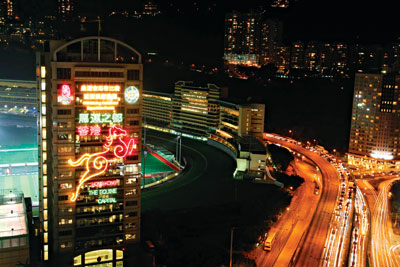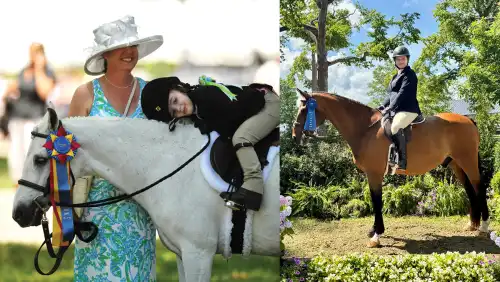
Amid the bright lights of the famous Hong Kong skyline, there is one particular neon display that might attract the attention of equestrians. On the skyscraper that houses the Hong Kong Jockey Club headquarters, a horse appears at night, along with the slogan: “Hong Kong: The Equine Capital.”
Perhaps the city of 7.5 million people isn’t the first destination that equine enthusiasts would consider as catering to their kind, but the HKJC members are preparing to showcase their love of the horse to the rest of the world in the 2008 Olympics.
Due to disease concerns in Beijing, Hong Kong was chosen primarily for its history of stringent quarantine, controlled equine population and veterinary expertise.
The British brought Thoroughbreds to Hong Kong in 1841, when they drained a swamp to make a track. Today, 1,200 Thoroughbreds live in Hong Kong at the Sha Tin racecourse, which will be part of the main Olympic venue along with the neighboring Hong Kong Sports Institute. The HKSI’s facilities have been converted into arenas, media areas, dining rooms and more while the Hong Kong athletes train elsewhere for Beijing.
The badminton hall at HKSI has been turned into an air-conditioned indoor arena, where riders can train or warm-up for competition.
The main arena, which was formerly a soccer field, has a running track around it, which is where the grandstands will be. Construction on the grandstands, which will be arriving in containers from Europe, starts in February. The footing in the main arena, which is 80 x 120 meters, is all-weather sand designed by German footing expert Oliver Hoberg. The tarmac for the horse inspections is beside the main arena, so spectators can see the horses from the stands.
“Everything is very tight,” said John Ridley, Head of Racing Operations for HKJC. “The spectators will be right on the arena.”
New, air-conditioned stables at Sha Tin have been completed for the Olympic horses. Grooms’ accommodations and spectator areas still need to be constructed, but the whole venue is slated for completion by May of 2008 and is well on schedule.
The infield of the track includes Penfold Park, a public park frequented by dog walkers and other city dwellers seeking a small bit of greenery. Parts of the park have been converted into arenas for training during the Olympics, and there are some cross-country schooling fences (including a water jump), galloping tracks and a polytrack bridle trail. The Thoroughbreds are already using the track, which will be a permanent legacy from the Olympics.
Horses will not be racing during the Olympics, as their season typically runs from September through the beginning of July to avoid the hottest months. Although they’ll use the track to train in the mornings, they will be working in separate places and different times from the Olympic horses.
A pavilion in Penfold Park has been erected to educate the local population about horses and horse sports, and officials hope to replace this pavilion with an Olympic museum as another legacy from the Olympics.
A new veterinary clinic is being built near the stables for the Olympic horses. This facility will complement the extensive clinic, with surgical facilities, in Sha Tin.
The horses arriving for the Olympics will be held in isolation, kept apart from the permanent residents of the track for the duration of the event. Officials are rebuilding the quarantine area typically used for horses arriving to race, and the 25 reserve horses for the Olympics will be stabled there, also isolated.
The rest of the Olympic horses will be in new barns, with rubber mats made from recycled tires and recycled bamboo shoots for stall walls and doors.
Spectators will not be able to drive or take a taxi to the venue but will arrive by bus, shuttle or train.
One Thing Beyond Control
According to Bob Howlett, principal information officer for the government, Hong Kong weather will be at the top end of humidity scales for the past four Olympic Games. “It’s not far off,” he said.
ADVERTISEMENT
Three “reserve dates” have been worked into the schedule in case of extreme weather.
“We will try not to use the reserve dates, just to shift the schedules,” said Mark Pinkstone, manager of equestrian events of the Games. “There are two conditions under which we would have to suspend competition—if there’s a severe typhoon or thunderstorms.”
With 12 days of competition, there’s a high possibility of a typhoon. Thunder-storms are common but often localized. If there’s a frontal typhoon, the city closes down for 1 1⁄2 days, but the probability of that is low. Typhoons come with plenty of warning; it’s the storms that are harder to predict.
“The last few years we’ve had very few frontal attacks,” said Pinkstone.
Officials estimate a 50 percent chance for a typhoon. “If the winds are over 110 kilometers an hour, it will take 10 hours to batten down [all temporary structures] and 20 hours to reset,” he said.
Four-wheel drive gators with tanks of chilled water will be ready to drive to any horse that might overheat. The Jockey Club will also be able to use this in the future for its race horses.
For the cross-country, which will be held at Beas River Country Club and adjoining Hong Kong Golf Club, the horses will ship to the venue the night before competing, then return to Sha Tin three hours after competing. Temporary stables and grooms’ quarters will be there.
The 10-minute course, designed by Mike Etherington-Smith, has several loops, designed such that if the weather is exceptionally hot or wet, one or even two loops could be removed to shorten the test.
“It’s built-in risk management,” said Ridley. “We have plan B, C, and D. We can take off a 100-meter loop, a 500-meter loop, or both. We will be relying on the vets’ advice.”
The water jumps, riveting for ditches and earth works (for the drainage) have all been completed. “They are constructing the permanent jumps now, working around golf dates,” said Ridley.
Hoberg, the footing consultant, had drain pipes installed all along the course, and the footing is designed to handle huge amounts of rain. The rings drain at 130 mL/hour, and the cross-country jump zones drain at 100 mL/hour.
The test event was held on the exact days that cross-country will run in 2008 and provided the perfect test, with just less than 2 inches of rain an hour before cross-country started.
“It held up very well for a new course,” said Ridley. “We’ve done a lot of maintenance work since then.”
Public Interest
Officials have started promoting the Olympics with signs in the airport and around the city, and they plan to do a major campaign at the 200-day and 100-day countdowns.
“We want to build up the Olympic atmosphere; we want people to feel it is an Olympic city,” said Brett Free, of the Hong Kong information services department.
On May 2, the Olympic torch relay will arrive in Hong Kong, which will be the first city in China to receive the torch.
Screens will be set up in downtown Hong Kong for people to watch the Games live. In the Times Square area of the city, 50,000-80,000 people will be able to watch, with a commentary in Cantonese.
ADVERTISEMENT
For athletes who want to attend the Opening Ceremony in Beijing, the three-hour flight will be paid for, and they will stay overnight in the Beijing Olympic Village. This won’t be possible for the eventers, who start competition at 6:30 a.m. the following day. But after the Games, the teams may all fly to the Closing Ceremony. There will be a live broadcast of the Opening Ceremony at a welcome party in Hong Kong.
Olympic Figures
-19,000 seats for main arena
-20,000 spectators will be admitted to cross-country course
-1,000 Hong Kong Jockey Club employees involved in running the Olympics, along with 1,800 volunteers
-200 horses, 25 reserve horses
-12 days of competition (Aug. 9-21)
-220,000 tickets available for 12 sessions
-13 training arenas
The Hong Kong Equestrian Scene
Approximately 1,500-2,000 people in Hong Kong ride, at one of nine schools, four of which are owned and run by the Hong Kong Jockey Club. Most of the horses are retired race horses from Sha Tin, along with a few ponies left by a Russian circus. All horses are located at the track or at one of the schools—there are no private stables.
“Equestrian sport suffered after the handover [of the British to the Chinese in 1997], because many English left,” said Soenke Lauterbach, HKJC manager of equestrian affairs. “But the sport is coming back now, and 60 percent of our riders are now Chinese. Many of them are boys and men, almost 40 percent. It’s considered a risky sport, which is part of the excitement, but it’s not considered a sport just for women.”
In fact, women cannot ride in the Hong Kong races following the fatality of a female jockey several years ago.
Ten percent of Hong Kong riders compete, starting at 60-70 centimeters and competing up to 1.2 meters. Hong Kong hosted a CSI-W in October and November for the Southeast Asian League, and regular dressage, jumping and eventing competitions are held.
Hong Kong equestrian officials hope to have a jumping team competing in the Olympics, as well as an individual dressage rider. As the host nation, they’re given a team jumping spot and individual dressage and eventing spots. They will also have three Grade 2 dressage candidates for the Paralympics to be held there the month after the Olympics.
A Drug-Free Olympics?
After the individual gold medalist in show jumping at the 2004 Athens Olympics had his medal stripped due to a drug infraction, the Hong Kong Jockey Club hopes to ensure a fair playing field for the 2008 Games.
Their world-renowned lab will handle samples from the Olympics, likely returning negative results in five days and positive results within 10 days. The lab has performed “referee” analyses on more than 500 samples from 20 different overseas authorities, including the Fédération Equestre Internationale. In fact, they confirmed three of the four “B” samples from positive cases in the 2004 Olympics.
For the Olympics, riders can request a test for a particular substance to make sure their horse is clean before the competition. The fee is $200 per substance tested. “We want to help people comply,” said Terry Wong, director of the racing lab.
Racing For Charity
The Hong Kong Jockey Club operates as a non-profit organization, and 100 percent of its profits are returned to the community, especially to help the elderly, sick, young and disabled. The Club has contributed more than $10 billion Hong Kong dollars to the community over the past decade.
While the HKJC has contributed more than $150 million dollars in building the Olympic venues, that money doesn’t detract from its an-nual charitable contributions but comes from its reserves.
With donations supporting medical and health projects, education, sports, recreation and culture, and other community services, its maxim is “Racing for Charity.”
The organization contributed to charities beginning in 1915, but in 1955, as the nation tackled post-war construction and an influx of immigrants, the Club formally adopted the policy of donating its surplus to charity each year.
Beth Rasin














